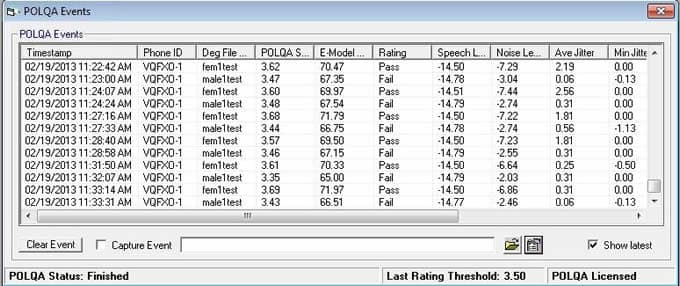GL Announces Enhanced Voice Quality Testing Solutions
Welcome to a September 2013 issue of GL Communications' Newsletter providing information on our enhanced Voice Quality Testing Software with Perceptual Objective Listening Quality Analysis (POLQA) standard for NB, WB, and SWB signals.

Overview
GL's enhanced VQuad™ and stand-alone Voice Quality Testing (VQT) software, both support the next-generation voice quality testing standard for fixed, mobile and IP-based networks using POLQA (ITU-T P.863).
POLQA, Perceptual Objective Listening Quality Analysis, based on ITU standard, ITU-T P.863, is the successor of PESQ (ITU-T P.862) analysis. POLQA supports the latest HD-quality speech coding and network transport technology with higher accuracy for 3G, 4G/LTE and VoIP networks.
The VQT software also supports other international standard voice quality test methods including PESQ (ITU-T P.862), PESQ LQ / LQO (P.862.1), PESQ WB (P.862.2), PAMS (ITU-T P.800), and PSQM/PSQM+ (ITU-T P.861).
About VQuad™ and VQT
Using the GL's VQuad™ application along with the Dual UTA, T1/E1 Probe, or SIP options, the user can configure manual and automated tests between practically any interfaces to conduct voice and data quality testing over any network.
The results associated with the POLQA analysis include POLQA MOS, E-Model, Signal Level, SNR, and Jitter measurements. The most eminent result of POLQA is the MOS-LQO. It directly expresses the voice quality on the MOS scale. POLQA supports both Narrowband (NB, 8000 sampling rate) and Super Wideband (SWB, 48,000 sampling rate). The SWB mode is most often used in WB VoIP codecs and HD voice codecs.
The Dual UTA (Universal Telephone Adapter) hardware supports several interfaces including:
- Bluetooth®, WiFi, 3G, 4G, LTE - Smartphones (iPhone, Android)
- Mobile Radio phones / Push to Talk (PTT, connects to any mobile radio supporting PTT and tx/rx voice)
- 2-wire analog FXO (simulates an analog phone)
- 4-wire analog balanced (connects to any mic/speaker combination)
- RJ22 phone handset (replaces any phone handset at the curly cord)
- VoIP Phones (SIP, H.323, RTP supported)
- TDM – ISDN and SS7 networks supported
The VQT software can be configured to automatically analyze the voice files collected by VQuad™ probes, and send the results (POLQA, PESQ, PAMS, PSQM) to the central database.
Important Enhancements
The following is brief list of enhancements introduced with latest release - VQuad™ version 6.15, and VQT version 5.0
- Both VQuad™ and VQT support POLQA Analysis for NB (8000 sampling), WB (16000 sampling) and SWB (Super Wideband) (48000 sampling) signals for both manual and automated tests.
- Supports displaying POLQA results within VQuad™ and sending the POLQA results to the central database where WebViewer™ can query and display either in tabular or graphic format.
- The VQT application supports the following optional measurement algorithms, POLQA, PESQ, PAMS, PSQM.
- The VQT can be controlled remotely through the included CLI with support for Windows® and Linux.
- VQuad™ Auto Configuration feature provides a simplified way to build user-defined scripts. Using this option the user can configure call control and traffic parameters to send/receive various traffic such as Voice files, DTMF/MF Digits, and Single/Dual-Frequency Tones. As part of the Auto Configuration, the VQuad can perform/initiate analysis functions such as VQT (including POLQA), Echo Measurement (EMU), Delay Measurements (RTD/OWD), SNR, C-Message, and Path Confirmation.

- VQuad™ includes an option to randomize the White Noise generation by specifying the lower and upper bound values.
Other VQuad™ Features
- Supports new data tests for Mobile devices (i.e. iPhone, Android) as well as PC Ethernet connection (wired, Wi-Fi, Broadband (3G or 4G))-
- Email send / receive
- SMS send / receive
- Phone Info, Phone SIM info, and Phone UE info
- Allows sending the results from manual tests to central database with 'Send Results' option
- FXO Call Progress detection supports Energy detection. The user can specify the Dial tone and Ring back tone detection as either specific frequencies or simply as energy detection with qualification time. This will allow easier detection of FXO call progress tones on certain networks.
- Option to connect to the VQuad™ behind the router to central DB. With this setting, VQuad™ will send network status periodically to the WebViewer™ rather than the WebViewer™ requesting information. Both VQuad™ and Data Import are enhanced to support WebViewer™ network status if VQuad™ is located behind a router.
- Added auto response on local VQuad™ event screen of far-end connection when bi-directional connection is performed. Also, ads ability to auto disconnect the bi-directional connection from the near-side device.
- Enhance VQuad™ CLI to support filtering responses based on which CLI is requesting the feedback. In other words the results of the CLI request (getes or gstatus) will be sent solely to the requested CLI
- Support for Windows® 7 32-bit and 64-bit versions
- Included new commands to VQuad™ CLI - starts, stops, and gets options to retrieve all Call Progress and Idle events; slog and glog options to retrieve information from VQuad™ client event screen.
For comprehensive information on the application, please visit Voice Quality Testing Software web page.


 Back to Newsletter Index Page
Back to Newsletter Index Page